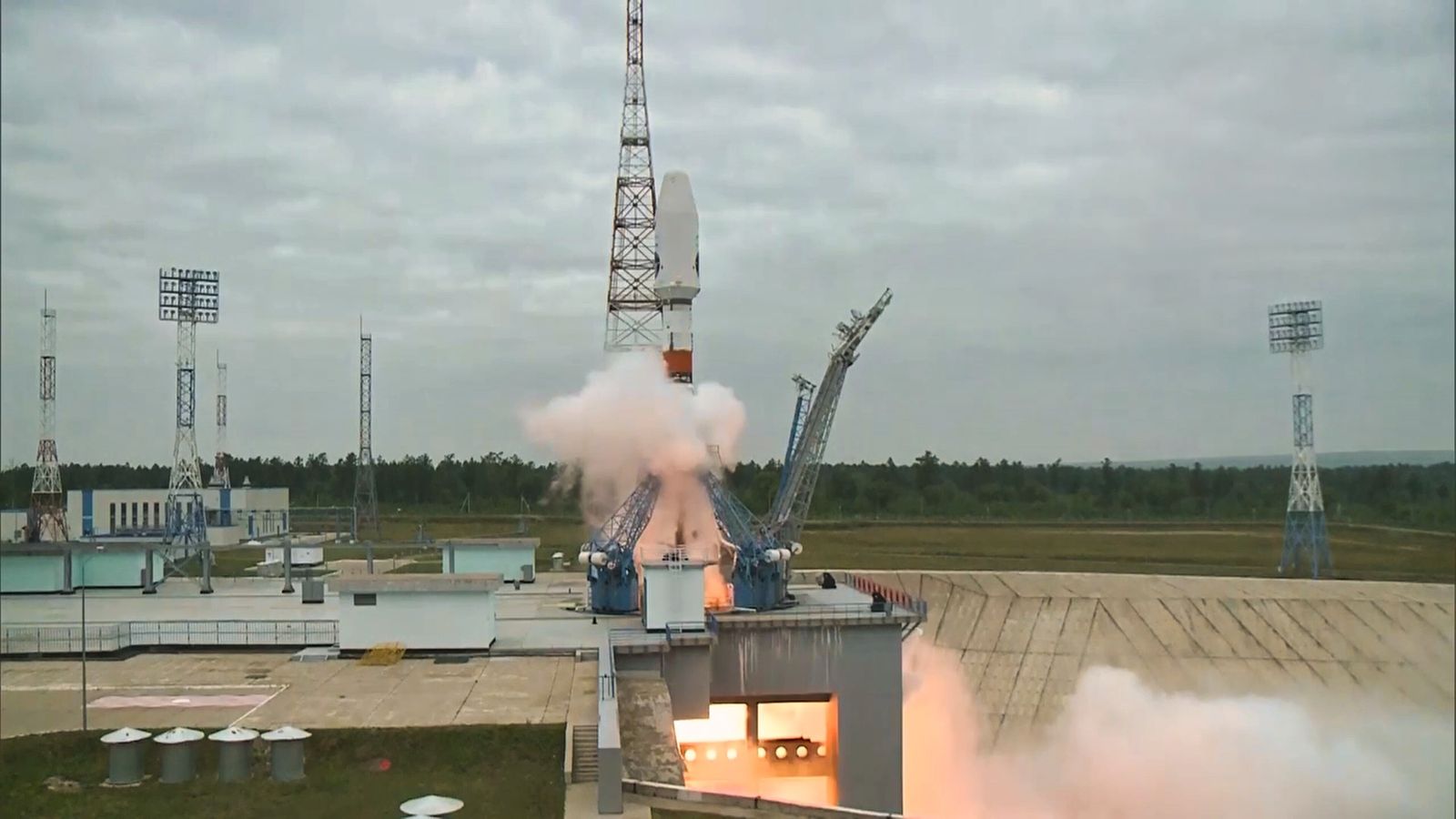Russia Joins The New Space Race Toward The South Pole
Russia joins the new space race toward the South Pole as the Russian space agency shares the initial images sent by its Luna-25 spacecraft, marking its return to lunar missions after a gap of nearly five decades since 1976. These images arrived approximately one week after India's Chandrayaan-3 spacecraft also captured video footage of the extensively pockmarked lunar landscape.
Author:Dexter CookeReviewer:Hajra ShannonAug 16, 20234.1K Shares147K Views

Russia joins the new space race toward the South Poleas the Russian space agency shares the initial images sent by its Luna-25 spacecraft, marking Russia's return to lunar missions after a gap of nearly five decades since 1976. These images arrived approximately one week after India's Chandrayaan-3 spacecraft also captured video footage of the extensively pockmarked lunar landscape. Both countries have plans to successfully land their scientific robots in the ice-abundant southern pole of the moon within the next couple of weeks.
Leading the current project is the Indian Space Research Organisation (ISRO), which has gained recognition for achieving significant feats within a relatively modest budget of around $1 billion per year (equivalent to 35 billion baht). The focus of this endeavor is a gentle landing at the Moon's South Pole.
Back in 2008, India's lunar orbiter Chandrayaan-1 played a pivotal role in revealing the presence of water molecules within lunar soil. The deep, perpetually shaded regions of the southern polar area, untouched by full sunlight, present an ideal location for investigating actual water ice. Building on this discovery, ISRO took a step further in 2019 with Chandrayaan-2, which embarked on the first-ever attempt at a lunar landing in the South Pole region.
The primary spacecraft, often referred to as the "mother ship," remains in orbit, continuing its observations. Regrettably, during the previous mission, the lander and surface rover it dispatched encountered an unfortunate mishap, crashing due to an untimely shutdown of the braking jets a few seconds too early. To follow up on these efforts, Chandrayaan-3 has been slated for deployment with its lander scheduled to touch down on either the 23rd or 24th of this month.
Interestingly, ISRO has strategically chosen these dates to coincide with the commencement of the two-week lunar day. This deliberate timing ensures that their lander and the accompanying surface rover have the greatest possible period to recharge their batteries using sunlight before the onset of the ensuing two-week lunar night.
Initially, Russia's space agency, Roscosmos, had originally selected the same landing date, evidently with the same rationale. However, in a recent development, during the launch of Russia's South Pole mission last week, Yuri Borisov, the head of Russia's space program, stated on state television that their landing was now anticipated for the 21st of the month. Addressing workers at the Vostochny cosmodrome in the Russian Far East, Borisov expressed the aspiration to secure the first landing, stating, "We hope to be the first."
This endeavor is physically achievable due to the substantial size of the Russian rocket, Luna-25, named sequentially after the last Russian lunar mission in 1976, Luna-24. Notably, this rocket carries a lander that is only half the mass of its Indian counterpart. If the Russian team opts not to extensively survey the landing site for potential hazards (in contrast to the Indian approach), they could potentially succeed in landing their lander first.
Interestingly, the Indians might inadvertently come out ahead, even though they're not actively competing. This is due to the strategic advantage of landing at the South Pole before lunar "Sunrise," a factor that could pose challenges for the Russian lander's optics in distinguishing between large rocks and deep depressions on the uniformly gray lunar terrain. This scenario increases the likelihood of a critical miscalculation.
Roscosmos, the Russian space agency, seems willing to embrace this risk, possibly due to external directives, given the context of Russia's involvement in Ukraine and the subsequent underwhelming performance of its military operations. Demonstrating technical prowess to international customers has become imperative for the regime, as has the need to bolster domestic morale.
However, if both landers manage to touch down safely, the Russians wouldn't gain a significant long-term advantage by being the first to land. The Indian response to the Russian initiative has been mature, considering the broader perspective. The Outer Space Treaty, established in 1967, dictates that no nation can assert ownership over the Moon.
A subsequent agreement known as the Moon Agreement, inked in 1979, goes into greater detail, stipulating that no country, organization, or private individual can claim ownership of lunar resources. It's noteworthy, however, that only four nations have endorsed this agreement, excluding major players like the US, China, and Russia.
This occurrence marks the first instance where a specific lunar region has garnered importance among spacefaring nations. If indeed the South Polar region harbors substantial frozen water deposits, it becomes a logical hub for missions venturing beyond the Earth-Moon system towards other celestial bodies.
Securing a reliable source of electrical power, whether through solar panels or compact nuclear reactors, opens the door to a range of possibilities. One such prospect is the ability to tap into and melt the ice, effectively solving the challenge of obtaining drinking water.
By employing electrolysis, the water can be split, yielding oxygen for breathing purposes and hydrogen for use as rocket fuel. Integrating hydroponics for food cultivation completes the basic necessities for self-sufficiency.
The feasibility of this approach hinges on the precise location of the water ice deposits. There's a potential for intense competition over the most optimal sites near the South Pole.
On one side, China and Russia are strong contenders, with plans to initiate construction of their Moon base, known as the International Lunar Research Station (ILRS), as early as 2026. On the other side are members of the US-led Artemis Accords, forming a potential rival faction vying for lunar resources and territories.
Artemis comprises nations with substantial lunar exploration capabilities, including the US, India, France, Japan, Korea, Israel, and the United Arab Emirates. The US intends to conduct a crewed lunar mission to the southern pole in 2025, setting the stage for the unfolding rivalry between the ILRS and the Artemis Accords coalition.
Conclusion
The direction of this competition will hinge on the presence of numerous, broadly dispersed water ice deposits around the pole. Should these resources prove abundant, both factions will maintain their stance that the competition remains amicable. Conversely, if such resources are lacking, tensions might arise.
Jump to

Dexter Cooke
Author
Dexter Cooke is an economist, marketing strategist, and orthopedic surgeon with over 20 years of experience crafting compelling narratives that resonate worldwide.
He holds a Journalism degree from Columbia University, an Economics background from Yale University, and a medical degree with a postdoctoral fellowship in orthopedic medicine from the Medical University of South Carolina.
Dexter’s insights into media, economics, and marketing shine through his prolific contributions to respected publications and advisory roles for influential organizations.
As an orthopedic surgeon specializing in minimally invasive knee replacement surgery and laparoscopic procedures, Dexter prioritizes patient care above all.
Outside his professional pursuits, Dexter enjoys collecting vintage watches, studying ancient civilizations, learning about astronomy, and participating in charity runs.

Hajra Shannon
Reviewer
Hajra Shannona is a highly experienced journalist with over 9 years of expertise in news writing, investigative reporting, and political analysis.
She holds a Bachelor's degree in Journalism from Columbia University and has contributed to reputable publications focusing on global affairs, human rights, and environmental sustainability.
Hajra's authoritative voice and trustworthy reporting reflect her commitment to delivering insightful news content.
Beyond journalism, she enjoys exploring new cultures through travel and pursuing outdoor photography
Latest Articles
Popular Articles
